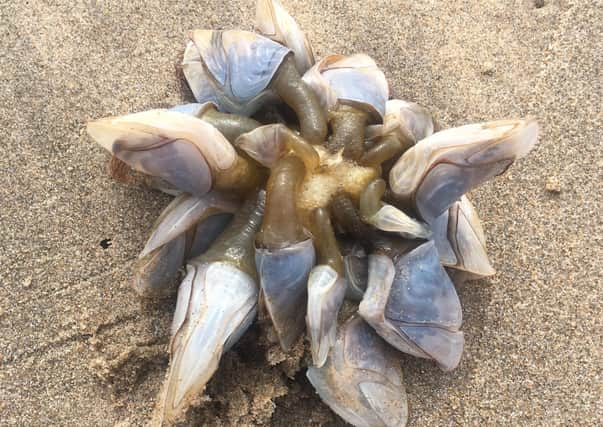‘No, an alien has NOT landed on NI beach’ - UFO link ruled out


Dozens of the creatures, about the size of a grapefruit, appeared on the beach at Whitepark Bay last week. But holiday makers, dog walkers and locals were all baffled by what it was.
The News Letter newsroom was also stumped, with one seasoned but shocked newshound describing it as “creepy”.
Advertisement
Hide AdAdvertisement
Hide AdA biologist from Queens University Belfast - appropriately enough, named after a mythological creature - Dr Donal Griffin quickly stepped up to the mark, confessing: “I have never actually seen one of these in real life”.
Now working for the Wildlife Trust in England, he says they have also been getting photographs of the same creature to identify from other beachcombers around the UK.
However he quickly cleared up the mystery, clarifying that from photographs, he was able to say this had not been a single life form but rather a collection of organisms.
“They look like washed out goose barnacles to me,” he said. “I’m not sure why they would be washing up in huge numbers at the moment, other than to say that they may have attached themselves to hard surfaces in the oceans and around the coast, and can become dislodged during storms and high wave action.”
Advertisement
Hide AdAdvertisement
Hide AdThe background information he supplied from the Wildlife Trust explained that the crustacean, related to crabs and lobsters, normally lives attached to rocks, ships, ropes or flotsam floating out at sea.
“They’ve even been spotted on a chunk of spaceship that washed up in the Isles of Scilly!” the profile added.
They have a long fleshy stem that looks like a black neck, which ends with a chalky white shell that houses the main body of the barnacle. It filter feeds on plankton.
“In many places in the world they are a delicacy - in fact, in days gone by, any ships arriving in Cornwall with Goose barnacles on the hull were a real moneyspinner.”
Advertisement
Hide AdAdvertisement
Hide AdDr Griffin added: “Normally they have a white head with a lovely yellow outline and dark brown or black stalks. But all the pigment has washed out of them. They normally have a shell like structure on the head but this could have fallen off or disintegrated. I am not sure because I have never actually seen one in real life.”
Despite their otherworldly appearance, however, he insists that nobody has ever suggested it might be some type of alien lifeform.
“No never,” he laughs. “They are strange but they are not uncommon really.”
A message from the Editor:
Thank you for reading this story on our website. While I have your attention, I also have an important request to make of you.
Advertisement
Hide AdAdvertisement
Hide AdWith the coronavirus lockdown having a major impact on many of our advertisers - and consequently the revenue we receive - we are more reliant than ever on you taking out a digital subscription.
Subscribe to newsletter.co.uk and enjoy unlimited access to the best Northern Ireland and UK news and information online and on our app. With a digital subscription, you can read more than 5 articles, see fewer ads, enjoy faster load times, and get access to exclusive newsletters and content. Visit https://www.newsletter.co.uk/subscriptions now to sign up.
Our journalism costs money and we rely on advertising, print and digital revenues to help to support them. By supporting us, we are able to support you in providing trusted, fact-checked content for this website.
Alistair Bushe
Editor